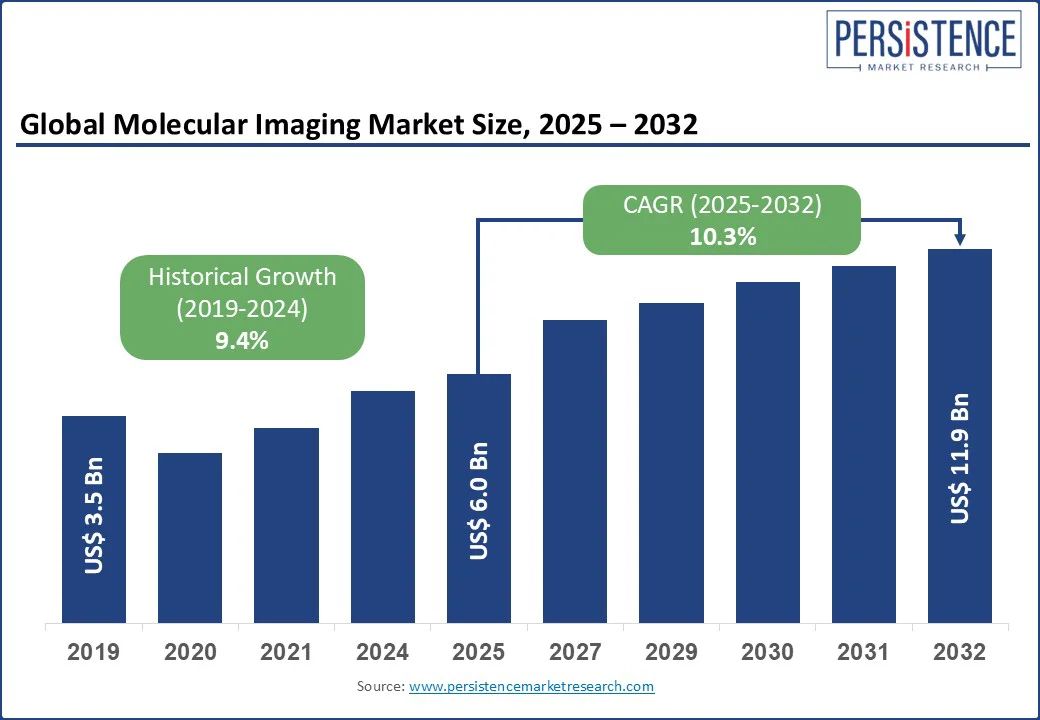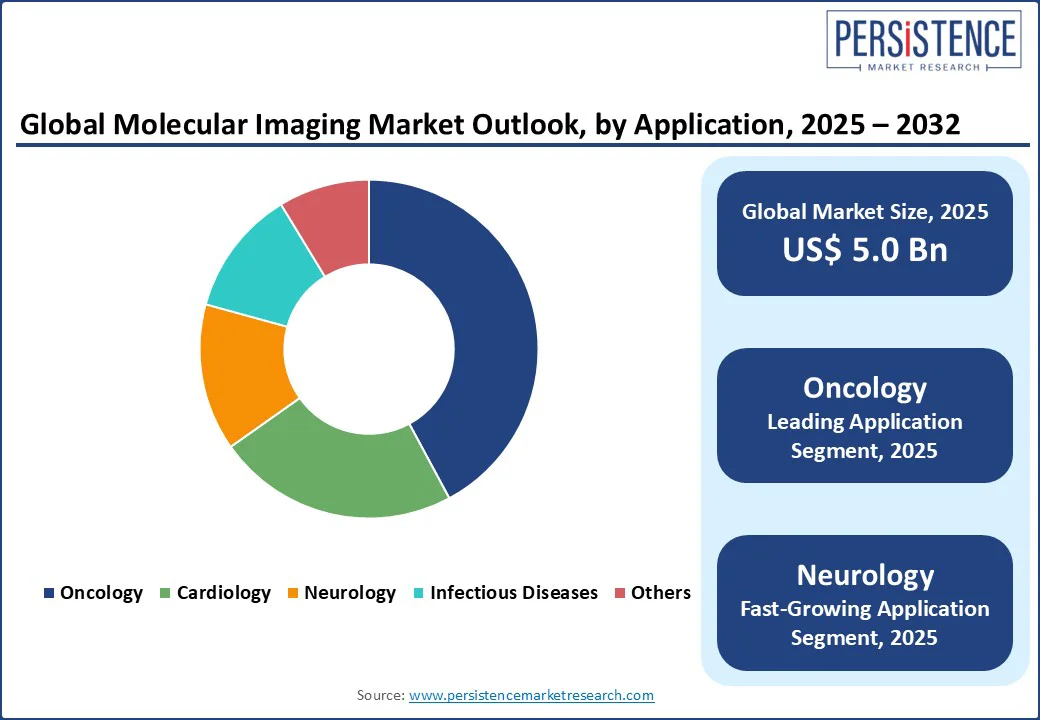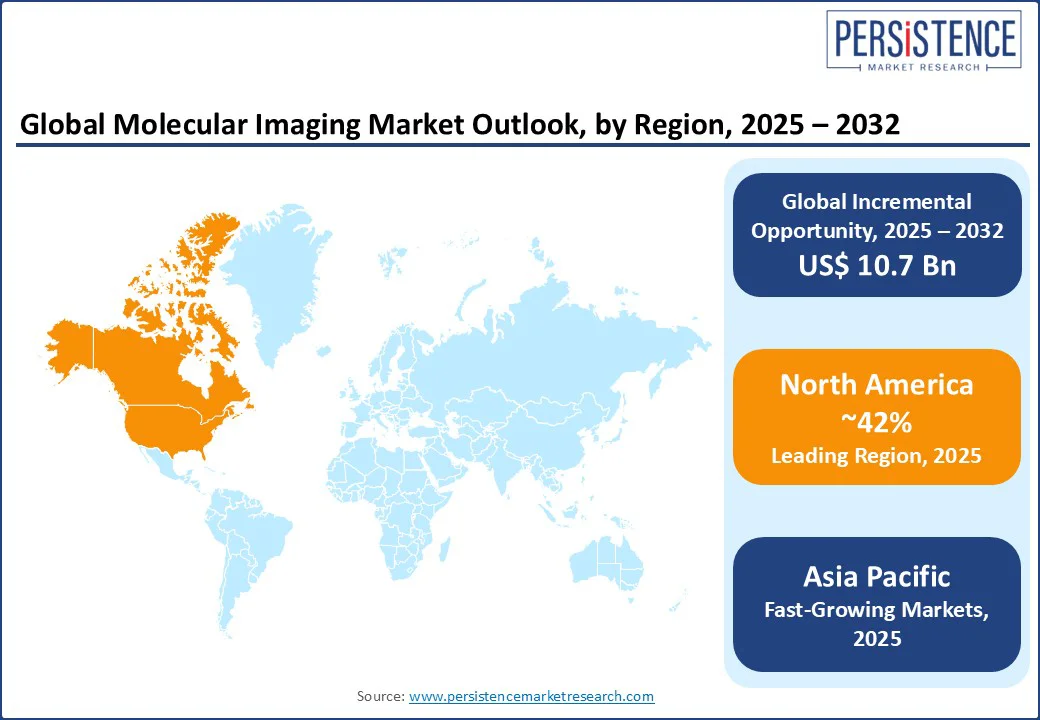ID: PMRREP34761| 198 Pages | 11 Aug 2025 | Format: PDF, Excel, PPT* | Healthcare

The global molecular imaging market size is likely to be valued at US$ 6.0 Bn in 2025 and is estimated to reach US$ 11.9 Bn by 2032, growing at a CAGR of 10.3% during the forecast period 2025−2032. Rising prevalence of cancer, genetic disorders, and an aging global population, triggers advanced diagnostic solutions. Molecular imaging is a cutting-edge biomedical technique that enables medical professionals to visualize, characterize, and quantify biological processes at the cellular and molecular levels within living organisms.
Unlike traditional imaging methods that focus on anatomical structures, molecular imaging provides functional insights by employing specialized imaging agents and technologies such as Positron Emission Tomography (PET), Single Photon Emission Computed Tomography (SPECT), and Magnetic Resonance Imaging (MRI).
Additionally, increasing demand for precise disease diagnosis and monitoring, particularly in oncology and cardiovascular care induces the demand for molecular imaging. Technologies such as PET/CT (Computed Tomography)and non-ionizing imaging systems are surging in popularity for their ability to enable images of biological processes at the cellular level.

Key Industry Highlights:
|
Global Market Attribute |
Key Insights |
|
Molecular Imaging Market Size (2025E) |
US$ 6.0 Bn |
|
Market Value Forecast (2032F) |
US$ 11.9 Bn |
|
Projected Growth (CAGR 2025 to 2032) |
10.3% |
|
Historical Market Growth (CAGR 2019 to 2024) |
9.4% |
Increasing prevalence of chronic conditions such as cancer, cardiovascular diseases (CVD), and neurological disorders is driving the molecular imaging market growth. For example, as per the World Health Organization (WHO), CVD kills around 17.9 million people every year, making it the leading cause of death globally. These health challenges are driving the demand for advanced diagnostic solutions, especially in aging populations. Molecular imaging technologies such as PET/CT and PET/MRI are able to meet these growing needs as they offer precise visualization of cellular processes, making them indispensable for early diagnosis and personalized treatment strategies.
The need for tailored diagnostics and therapies is further boosting the adoption of molecular imaging systems. Clinicians can more accurately assess individual patient profiles and monitor therapeutic responses with higher precision by employing these systems. Continued investments in research and development, particularly in the creation of targeted imaging agents further enhance the capabilities of molecular imaging modalities.
Despite its clinical value, molecular imaging is likely to witness slow adoption due to the high cost of equipment and procedures. Advanced systems such as PET/CT require significant capital investments upfront and frequent operational expenses, including specialized radiotracers and skilled personnel. These financial burdens restrict adoption in resource-limited settings and even pose challenges in developed regions where healthcare budgets are tight. Regulatory and reimbursement hurdles are also expected to impede market progress. Lengthy approval processes for novel imaging agents and technologies increase development costs and delay commercialization. Inconsistent reimbursement policies discourage healthcare providers from investing in molecular imaging solutions, particularly in emerging markets.
The integration of AI and machine learning is opening new avenues for growth in the molecular imaging market. These technologies have been proven to tangibly improve image analysis, diagnostic accuracy, and workflow efficiency, especially in complex modalities such as PET/MRI. AI algorithms can process vast imaging datasets to detect subtle patterns and anomalies, supporting more precise and timely diagnoses. Beyond diagnostics, AI and ML are also transforming personalized treatment planning by combining imaging data with genetic and clinical profiles. These tools enable real-time monitoring of therapeutic responses and facilitate adaptive treatment strategies.
Moreover, the automation of routine tasks and the use of decision support systems help mitigate skilled workforce shortages, boosting productivity in healthcare facilities. Companies are already innovating on this front. In June 2025, GE HealthCare unveiled LesionID Pro, its AI-driven, zero-click segmentation software for molecular imaging to automatically quantify whole-body tumor volume and streamline lesion analysis, significantly reducing manual workload and speeding the time?to?report. As AI and ML continue to evolve, their integration into molecular imaging is expected to drive innovation and elevate the standard of patient care.
Based on modality, the market has been segmented into molecular ultrasound imaging, positron emission tomography, and SPECT. Among these, SPECT is set to lead the market with a projected 43.3% share in 2025, attributable to its diagnostic precision and broad clinical applications. SPECT is widely used in cardiology and neurology for its ability to produce detailed 3D images of internal organs and tissues. Its effectiveness in assessing cardiac blood flow and detecting neurological disorders such as Alzheimer’s disease makes it an indispensable asset in clinical diagnostic procedures.
Some of the most ground-breaking technological advancements in SPECT include enhanced image resolution, faster scan times, and improved quantification techniques, which have noticeably boosted its adoption across healthcare settings. These innovations have not only improved diagnostic accuracy but have also streamlined workflows, fueling the demand for SPECT and making it a preferred choice among healthcare providers.
On the basis of application, the market has been divided into cardiology, neurology, and oncology. The oncology segment is projected to dominate this market with a 42.8% revenue share in 2025. The primary reason for this is the global rise in cancer cases and the subsequent demand for advanced diagnostic tools. Estimates released by the International Agency for Research on Cancer (IARC) show that there were 20 million new cancer cases and 9.7 million deaths worldwide due to the disease in 2022. Molecular imaging technologies have proven to be instrumental in oncology for their ability to detect malignancies early, provide highly accurate prognoses, and monitor treatment efficacy through detailed insights into metabolic and structural changes. With cancer incidence exhibiting a relentless rise globally, healthcare providers are increasingly adopting molecular imaging systems to improve diagnostic precision and patient outcomes.

North America is projected to dominate with a market share of approximately 42% in 2025, fueled by a well-established and well-functioning healthcare infrastructure and growing cancer prevalence. The region’s advanced medical capabilities, including widespread adoption of next-gen imaging technologies are strongly supporting favorable reimbursement policies and high healthcare spending. This offers patients a broad access to modern diagnostic tools across hospitals and clinics. The U.S. leads the regional market due to the increasing incidence of various cancer types, which has heightened the demand for precise and early-stage diagnostic solutions. The country is the prime force behind entrenching North America’s position as a leading contributor to the market growth.
Europe is gaining substantial traction, largely driven by its aging population and the rising prevalence of chronic diseases. The European Commission (EC) projects that there will be around 129 million people above the age of 65 living in Europe by 2050. These demographic shifts are increasing the demand for accurate and preemptive diagnostic technologies, positioning molecular imaging modalities such as PET, SPECT, and MRI as essential tools in modern healthcare. The growing emphasis on proactive care and early disease detection is further boosting the adoption of these advanced systems in the region.
In particular, the U.K. is emerging as a major driver of market expansion, with the country promoting investments in precision medicine and early diagnosis initiatives. As healthcare systems across Europe prioritize efficiency and personalized treatment, molecular imaging technologies are likely to become integral to clinical workflows, reinforcing the region’s considerable share in market revenue.
Asia Pacific is poised to grow at a CAGR of 5.54% through 2032, propelled by notable improvements in healthcare infrastructure across developing nations. Countries such as China, India, and those in Southeast Asia are heavily investing in hospitals and diagnostic centers and rise in budgetary allocation to healthcare to expand access to advanced medical technologies. This regional expansion is further supported by a growing focus on early disease detection and precision diagnostics. As these nations modernize their healthcare frameworks, the adoption of molecular imaging tools such as SPECT is set to accelerate in the coming years, positioning Asia Pacific as a key growth engine in the medical imaging market.

The global molecular imaging market landscape is shaped by intense competition among leading players such as GE Healthcare, Siemens Healthineers, Philips Healthcare, and Canon Medical Systems. With a view to retain their dominant market position, these companies are engaging in continuous innovations, broadening their product offerings, and entering strategic collaborations. Their focus on integrating cutting-edge technologies such as AI and hybrid imaging systems is enhancing diagnostic precision and clinical efficiency.
On the other hand, emerging firms and start-ups are concentrating on developing novel molecular imaging agents and modalities. The competitive landscape is being energized even more by massive investments in research and development and partnerships with academic institutions and healthcare providers. This dynamic environment is accelerating technological progress and expanding the global reach of molecular imaging solutions.
The molecular imaging market is projected to reach US$ 6.1 Bn in 2025.
Rising chronic disease burden worldwide is driving the market.
The molecular imaging market is poised to witness a CAGR of 10.8% from 2025 to 2032.
AI and ML integration to enhance diagnostic precision and the growing need for tailored diagnostics and therapies are key market opportunities.
Bruker, GE Healthcare, and Siemens Healthineers are some of the key players in the market.
|
Report Attribute |
Details |
|
Historical Data/Actuals |
2019 – 2024 |
|
Forecast Period |
2025 – 2032 |
|
Market Analysis |
Value: US$ Bn |
|
Geographical Coverage |
|
|
Segmental Coverage |
|
|
Competitive Analysis |
|
|
Report Highlights |
|
|
Customization and Pricing |
Available upon request |
By Modality
By Application
By End-user
By Region
Delivery Timelines
For more information on this report and its delivery timelines please get in touch with our sales team.
About Author